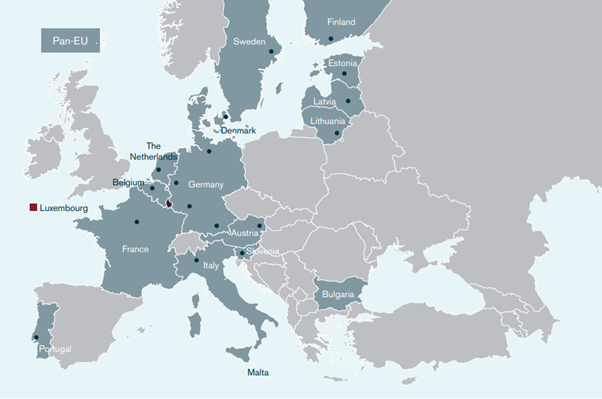Unified Patent Court offers new opportunities for effective enforcement of European patents
Published on 4th May 2023
The UPC becomes operational on 1 June and introduces major changes to patent litigation across Europe

The long-awaited Unitary Patent (UP) and the Unified Patent Court (UPC) will become a reality at the start of June. For the first time, the new UP will introduce a single patent right covering all EU Member States that have ratified the UPC Agreement. In parallel, the UPC opens up the possibility of pan-EU injunctions and central patent revocation for both UPs and European Patents (EPs) that have not been opted out of the new court system. The new system will result in substantial changes to the current process of granting and litigating patents in Europe. What will the new system look like and what new opportunities does it present?
The UPC: the basics
As it currently stands, when the UPC goes live on 1 June there will be 17 EU Member States participating in the system (as indicated on the map below). Unless and until other EU countries join, UPC rulings will only have effect in those 17 countries. As the UK is no longer an EU Member State, it will not be participating in the UPC. Other non-EU European Patent Convention (EPC) contracting states will also not be able to participate.

The UPC itself is comprised of a Court of First Instance, a Court of Appeal, and a Registry. In addition, there will also be a Patent Mediation and Arbitration Centre and a Training Centre. The Court of First Instance will be divided into central, local and regional divisions.
| Court of First Instance | Court of Appeal | Registry | ||
|---|---|---|---|---|
| Central Divisions | Local divisions (number of legally qualified judges) | Regional divisions (number of legally qualified judges) | Luxembourg | Paris, France (central Registry) |
| Paris, France Munich, Germany | Vienna, Austria (1) Brussels, Belgium (1) Copenhagen, Denmark (1) Helsinki, Finland (1) Paris, France (2) Düsseldorf, Germany (2) Hamburg, Germany (2) Mannheim, Germany (2) Munich, Germany (2) Milan, Italy (2) Lisbon, Portugal (1) Ljubljana, Slovenia (1) The Hague, the Netherlands (2) | Nordic-Baltic division (2) : Stockholm, Sweden Vilnius, Lithuania Riga, Latvia Tallinn, Estonia | ||
| Patent Mediation and Arbitration Centre | Training Centre |
|---|---|
| Ljubljana, Slovenia Lisbon, Portugal | Budapest, Hungary |
The aims of the UPC
The UPC is intended to create a simpler procedure for patent litigation, by becoming a "one-stop shop" venue, ending the need to bring different actions in different jurisdictions. It also aims to reduce costs through eliminating unnecessary litigation and translation fees.
The UPC will have exclusive jurisdiction to hear actions relating to the new Unitary Patent. During the initial seven-year transition period, the UPC and national courts will also have parallel jurisdiction to hear actions relating to classic European Patents that have not been "opted out" of the UPC system, meaning that litigants can choose to bring proceedings either before the UPC or the relevant national courts. At the end of the transition period, the UPC will assume exclusive jurisdiction for European Patents in the participating UPC states.
Benefits and risks
For patentees, the new system reduces the complexity and cost of litigation by eliminating the need to commence proceedings in multiple jurisdictions. This means that provisional and final relief will be enforceable across all UPC states. On the other hand, for non-patentees, declarations of non-infringement and revocation will be effective across all UPC states.
While the UPC does create a more centralised system, it is important to remember that many EU Member States are not currently participating in the system and non-EU EPC contracting states (such as the UK) are not able to participate. This means that separate proceedings will still be required in these countries.
Opting out
With the commencement of the UPC fast approaching, patent owners should consider now whether to exercise their opt out option. Once the court becomes operational on 1 June, an EP can be "locked in" to the system if proceedings are launched in UPC. This will include claims for revocation or declarations of non-infringement filed by third parties.
However, patent owners have a three-month window prior to the UPC going live (known as the "sunrise period") in which to opt out their European Patents from the UPC system entirely. The sunrise period began on 1 March 2023.
The default position is that patents are "opted in" to the UPC so decisions about opt out should be thoroughly considered before the court goes live. The decision on whether to opt out will come down to an analysis of benefits and risks for a business. The key factors to consider are the commercial importance of the patent, whether costs would be a barrier to enforcement across Europe under the current system of separate national proceedings, and confidence in the validity of the patent.
There is no single right answer to these considerations, particularly given that the UPC is an untested system. But, those who opt out can "opt in" again later by withdrawing their opt-out, provided that no action has been taken in national courts in the meantime. You cannot opt out again once an opt-out has been withdrawn.
Osborne Clarke comment
With the new system comes a number of strategic choices. For example, with respect to infringement claims, the claimant has the choice whether to bring a claim in the place of infringement or a location of the defendant's seat. This allows for a choice between different local and regional divisions, which could factor in convenience and the language of proceedings in the different locations.
With respect to revocation actions, if it is a standalone action then it must be brought in the central division. However, revocation claims can also be raised as a counterclaim in an infringement action. In those circumstances, the local or regional division can either deal with validity and infringement together or bifurcate the proceedings by referring the revocation claim to the central division and either staying or continuing with the infringement case. Also, if the parties agree, then the whole case may be sent to the central division.
Proceedings in the UPC are front-loaded – all substantial materials must be included with the claim. This not only includes setting out the nature of the claim and remedies sought, but also the evidence relied on; for example, witness statements, expert reports, experimental reports and so on. While this is similar to many continental European systems, it is in marked contrast to proceedings in the UK where the exchange of evidence takes place much later in the proceedings.
It is intended that the UPC will provide expeditious judgments, with the aim of a first-instance decision being handed down within 12-18 months. This is comparable to the timeline the UK, where the Patents Court aims to deliver first instance decisions within 12 months.
Although the UPC aims to simplify and streamline European patent litigation, the UPC will not cover all European markets and, therefore, parallel litigation will necessarily continue. This underscores the importance of having an appropriate Europe-wide litigation strategy. In formulating this, consideration should be given to the potential strategic use of litigation in non-UPC territories. This could include, for example, using English proceedings to obtain documents or samples, or seeking Arrow declarations to protect against UPC interim injunctions.
Undoubtedly, the UPC system will introduce major changes to the patent litigation landscape in Europe. Strategic decisions regarding opt out should be made ahead of the court becoming operational on 1 June. If you choose to participate in the new system, this opens up a range of options for enforcement of your patents, which should be weighed carefully and factored into a well-conceived Europe-wide litigation strategy.
This topic was recently discussed during Osborne Clarke's IP Month – the webinar recording and slides can be accessed by registering for the session.
Sophie Mullarkey, a Trainee with Osborne Clarke's IP Disputes team, contributed to this Insight.






